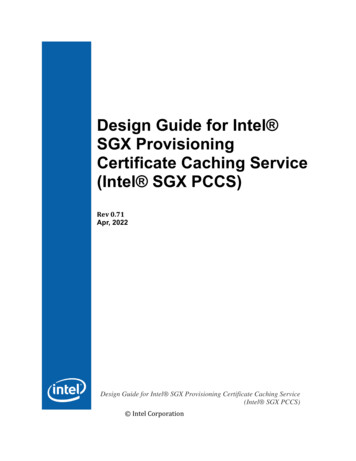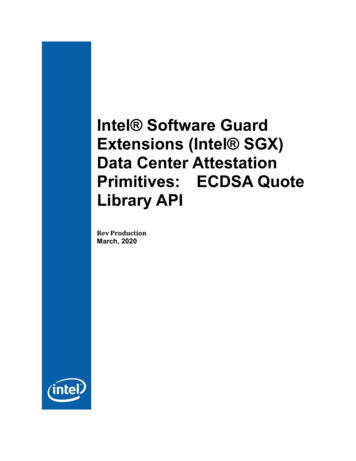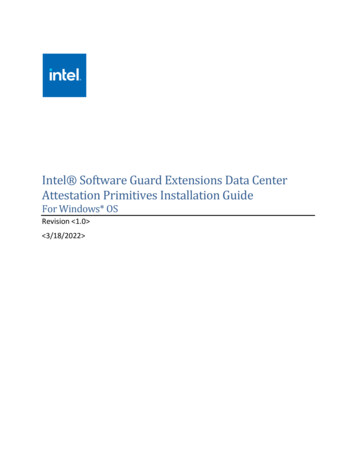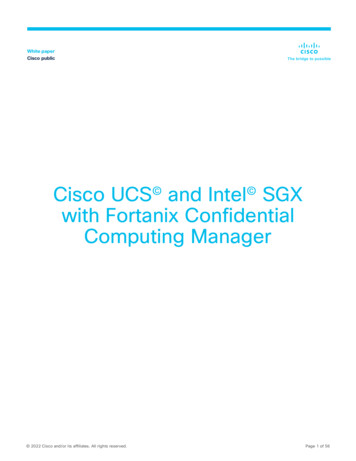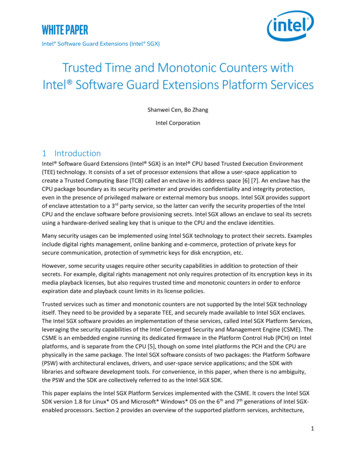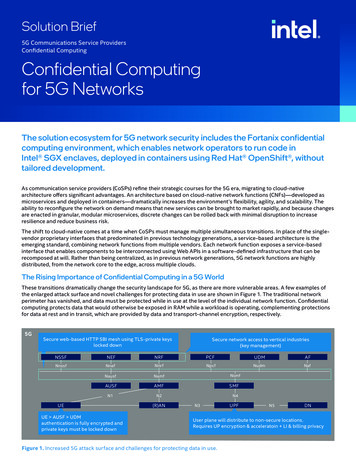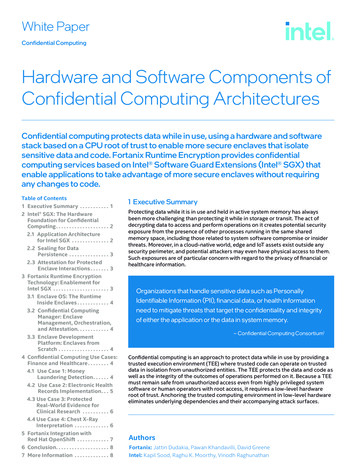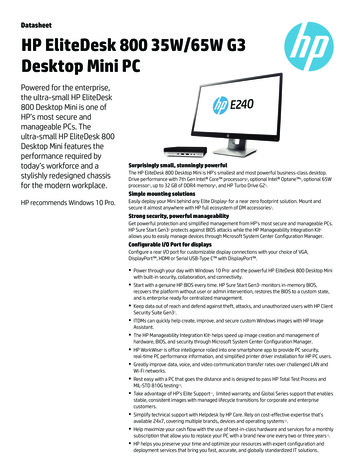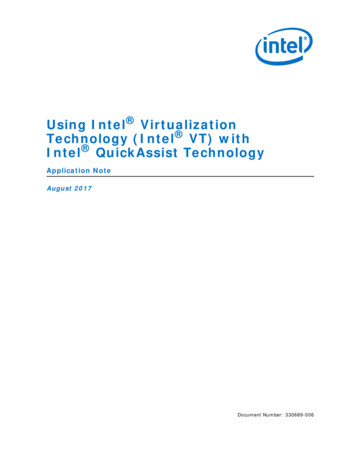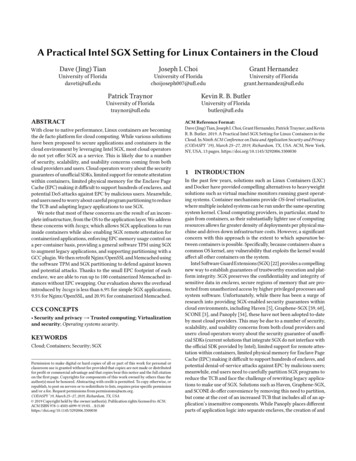
Transcription
A Practical Intel SGX Setting for Linux Containers in the CloudDave (Jing) TianJoseph I. ChoiGrant HernandezUniversity of Floridadaveti@ufl.eduUniversity of Floridachoijoseph007@ufl.eduUniversity of Floridagrant.hernandez@ufl.eduPatrick TraynorKevin R. B. ButlerUniversity of Floridatraynor@ufl.eduUniversity of Floridabutler@ufl.eduABSTRACTWith close to native performance, Linux containers are becomingthe de facto platform for cloud computing. While various solutionshave been proposed to secure applications and containers in thecloud environment by leveraging Intel SGX, most cloud operatorsdo not yet offer SGX as a service. This is likely due to a numberof security, scalability, and usability concerns coming from bothcloud providers and users. Cloud operators worry about the securityguarantees of unofficial SDKs, limited support for remote attestationwithin containers, limited physical memory for the Enclave PageCache (EPC) making it difficult to support hundreds of enclaves, andpotential DoS attacks against EPC by malicious users. Meanwhile,end users need to worry about careful program partitioning to reducethe TCB and adapting legacy applications to use SGX.We note that most of these concerns are the result of an incomplete infrastructure, from the OS to the application layer. We addressthese concerns with lxcsgx, which allows SGX applications to runinside containers while also: enabling SGX remote attestation forcontainerized applications, enforcing EPC memory usage control ona per-container basis, providing a general software TPM using SGXto augment legacy applications, and supporting partitioning with aGCC plugin. We then retrofit Nginx/OpenSSL and Memcached usingthe software TPM and SGX partitioning to defend against knownand potential attacks. Thanks to the small EPC footprint of eachenclave, we are able to run up to 100 containerized Memcached instances without EPC swapping. Our evaluation shows the overheadintroduced by lxcsgx is less than 6.9% for simple SGX applications,9.5% for Nginx/OpenSSL, and 20.9% for containerized Memcached.CCS CONCEPTS Security and privacy Trusted computing; Virtualizationand security; Operating systems security.KEYWORDSCloud; Containers; Security; SGXPermission to make digital or hard copies of all or part of this work for personal orclassroom use is granted without fee provided that copies are not made or distributedfor profit or commercial advantage and that copies bear this notice and the full citationon the first page. Copyrights for components of this work owned by others than theauthor(s) must be honored. Abstracting with credit is permitted. To copy otherwise, orrepublish, to post on servers or to redistribute to lists, requires prior specific permissionand/or a fee. Request permissions from permissions@acm.org.CODASPY ’19, March 25–27, 2019, Richardson, TX, USA 2019 Copyright held by the owner/author(s). Publication rights licensed to ACM.ACM ISBN 978-1-4503-6099-9/19/03. . . 15.00https://doi.org/10.1145/3292006.3300030ACM Reference Format:Dave (Jing) Tian, Joseph I. Choi, Grant Hernandez, Patrick Traynor, and KevinR. B. Butler. 2019. A Practical Intel SGX Setting for Linux Containers in theCloud. In Ninth ACM Conference on Data and Application Security and Privacy(CODASPY ’19), March 25–27, 2019, Richardson, TX, USA. ACM, New York,NY, USA, 13 pages. ONIn the past few years, solutions such as Linux Containers (LXC)and Docker have provided compelling alternatives to heavyweightsolutions such as virtual machine monitors running guest operating systems. Container mechanisms provide OS-level virtualization,where multiple isolated systems can be run under the same operatingsystem kernel. Cloud computing providers, in particular, stand togain from containers, as their substantially lighter use of computingresources allows far greater density of deployments per physical machine and drives down infrastructure costs. However, a significantconcern with this approach is the extent to which separation between containers is possible. Specifically, because containers share acommon OS kernel, any vulnerability that exploits the kernel wouldaffect all other containers on the system.Intel Software Guard Extensions (SGX) [22] provides a compellingnew way to establish guarantees of trustworthy execution and platform integrity. SGX preserves the confidentiality and integrity ofsensitive data in enclaves, secure regions of memory that are protected from unauthorized access by higher privileged processes andsystem software. Unfortunately, while there has been a surge ofresearch into providing SGX-enabled security guarantees withincloud environments, including Haven [5], Graphene-SGX [59, 60],SCONE [3], and Panoply [54], these have not been adopted to-dateby most cloud providers. This may be due to a number of security,scalability, and usability concerns from both cloud providers andusers: cloud operators worry about the security guarantee of unofficial SDKs (current solutions that integrate SGX do not interface withthe official SDK provided by Intel), limited support for remote attestation within containers, limited physical memory for Enclave PageCache (EPC) making it difficult to support hundreds of enclaves, andpotential denial-of-service attacks against EPC by malicious users;meanwhile, end users need to carefully partition SGX programs toreduce the TCB and face the challenge of rewriting legacy applications to make use of SGX. Solutions such as Haven, Graphene-SGX,and SCONE do offer convenience by removing this need to partition,but come at the cost of an increased TCB that includes all of an application’s insensitive components. While Panoply places differentparts of application logic into separate enclaves, the creation of and
communication with multiple enclaves per application increasesEPC memory consumption.In particular, when deploying SGX in a cloud environment, webelieve the following issues must be addressed: Retrofitting and evaluating Nginx/OpenSSL and Memcachedusing SGX based on lxcsgx. Compared to original native applications, the overhead is less than 9.5% for Nginx/OpenSSLand 20.9% for containerized Memcached.(1) Limited support for remote attestation: A critically importantfeature of SGX is its ability to attest to the identity and integrity of SGX applications to third parties (e.g., cloud users),but neither Haven nor SCONE provides native support forCPU remote attestation.(2) SGX application security: Solutions that involve placing entire applications within a secure enclave, such as Haven,Graphene-SGX, and SCONE, do not necessarily guaranteesecurity, as they can dramatically expand the TCB and maycontain vulnerabilities from within either applications or libraries, such as the Heartbleed [9] bug within OpenSSL.(3) Limited EPC memory: The current maximum EPC size is 128MB, with approximately 90 MB left for users after accountingfor enclave management [28]. While EPC page swapping issupported on Linux, it leads to a considerable performance hit.A cloud operator has a vested interest in minimizing the memory footprint of enclaves, which would allow the supportingof many users and reducing of performance degradation (dueto swapping) at the same time. The EPC limit also impliescloud providers need to protect the EPC from (malicious) overconsumption, a factor not considered by existing solutions.SGXv2 even allows dynamic EPC page allocation during theenclave runtime, exacerbating EPC memory consumption.1(4) Support for legacy applications: To reduce the TCB inside enclaves, Intel [21, 23] mandates program partitioning. Unfortunately, this makes programming for SGX non-trivial.2Outline. The remainder of this paper is structured as follows:Section 2 further motivates our work on lxcsgx; Section 3 describesthe design and implementation of lxcsgx; Section 4 shows how toretrofit applications by leveraging lxcsgx; Section 5 evaluates theperformance of lxcsgx and the applications built atop it. Finally wediscuss takeaways from our work in Section 6, while contrasting itagainst the existing literature in Section 7, and conclude in Section 8.We note that most of the concerns surrounding adoption of SGXsupported containers in the cloud are the result of an incompleteinfrastructure, from the OS to the application layer. We addressthese concerns through our development of lxcsgx, a platform fullyenabling Intel SGX deployment for Linux Containers (LXC) in thecloud environment. Unlike past solutions, we pay particular attention to the practical deployment concerns in a cloud environmentmentioned above. In so doing, our contributions include: Enabling SGX remote attestation for containerized applications. Compared to native host attestations, the overhead is6.9% and 4.9% for containerized local and remote attestations. Enforcing EPC memory usage control per container in theLinux kernel to prevent (malicious) overuse of resources. Implementing a GCC plugin to assist program partitioning toreduce the TCB in the enclave and better support scalability. Implementing a software TPM using SGX, providing a fasthardware TPM replacement as well as socket APIs for legacyapplications, which can access the TPM functionality in anattestable enclave instead of being fully refactored for SGX.The speed of TPM operations ranges from 10 to 280 µs.1We provide further discussion on why SGXv2 is not a panacea in Section 6.2 The Intel SGX SDK Developer Manual v1.9 has 320 pages.2MOTIVATIONSolutions allowing an entire application to run within an SGX enclavewithout any modifications, such as Graphene-SGX and SCONE, easethe integration of SGX with existing (legacy) applications. However,these approaches tend to bloat both TCB and enclave size, miss keyfeatures such as remote attestation, and ignore hardware constraintson EPC size (instead totally relying on EPC page swapping). Weexamine limitations of these solutions to further motivate our work.2.1Why could unofficial SDKs be problematic?We observe that some cloud providers (e.g., IBM and Azure [48])had SGX-capable servers available as early as 2017, but they did notofficially support SGX applications until recently. We speculate thatconcern over unofficial SDKs was a contributing factor to the holdup.Solutions built on customized software stacks or unofficial/homemade SDKs, such as Haven and SCONE, cannot provide nativesupport for remote attestation.3 Remote attestation requires Intel’sQuoting Enclave (QE), which leverages Intel Enhanced Privacy ID(EPID) [32] and is part of the Intel SGX software stack. The missingremote attestation is critical, because it provides cloud users with aguarantee that the desired enclave has the right measurement andis running on a genuine Intel CPU with SGX enabled (rather than asoftware emulator).4 Without such a guarantee, it is impossible toreason about the security of the SGX-supported cloud platform.5Runtime libraries within the enclave impose security concernsas well. Software Grand Exposure [7] and Cachezoom [40] haveshown that traditional crypto libraries inside the enclave, such as theOpenSSL used by Graphene-SGX and Panoply, are still vulnerableto cache-based side channel attacks. Intel Integrated PerformancePrimitives (IPP, built into the Intel SGX SDK) appears more securedue to its usage of AES-NI [30]. Similarly, putting glibc or musl6into the enclave naively, as Graphene-SGX and SCONE do, mightstill be a vulnerable practice due to the insecure functions included(e.g., strcpy). In contrast, all “dangerous” functions are removed fromIntel’s trusted C library, and “sensitive” functions are implementedusing hardware instructions (e.g., RDRAND for rand).3Haven’s attestation is emulated and requires trust in the cloud provider.4 SCONE provides only local attestation, which does not give the latter guarantee. Haven,while not strictly a container environment, does not support remote attestation either.5 With regard to the recent Foreshadow [61] attack, which leverages out-of-orderexecution to extract a SGX-enabled machine’s private attestation key and allows anadversary to forge valid attestation responses, Intel has released microcode updates [27].As stated by Van Bulck et al. [61], Foreshadow exploits an implementation bug and doesnot invalidate the architectural design of Intel SGX.6 https://www.musl-libc.org/
Compared to other SGX software stacks, the official Intel SGXSDK seems to be the most secure open-source solution, designed forsecurity and with defenses against Spectre attacks [34]. Azure alsoexclusively supports the Intel SGX SDK in its cloud environment [48].While other libraries may provide alternative means for attestationand hardening against attacks, reliance on them consequently altersthe SGX trust model. In the remainder of the paper, we assume theofficial Intel SGX SDK to be deployed in the cloud environment.2.2Why is program partitioning preferred?Program partitioning requires application developers to figure outthe most security-sensitive parts of the code, and transform them touse SGX. Though cumbersome, this methodology may be the bestsecurity practice to reduce the attack surface via reducing the TCBin the enclave. Because syscalls are not allowed inside the enclave,any SGX solution that does not require program partitioning insteadrelies on an additional middle layer (e.g., LibOS) to emulate thesesyscalls; this practice might bloat the TCB depending on the coverageof the emulation. Furthermore, as explicitly mentioned in the SGXDeveloper Manual [24]), putting vulnerable code into enclaves doesnot suddenly make the code secure.The other benefit of program partitioning comes from the potentially small EPC memory consumption in both loading time andruntime. The binary size of Drawbridge LibOS used by Haven is over200 MB, which is even beyond the maximum 128 MB EPC memorylimitation. While TCB size does not directly determine the memoryconsumption, they are related. For example, a partitioned OpenSSLlibrary in Panoply takes around 6 MB of EPC memory, whereas anunmodified library takes 65 MB in Graphene. To assist with programpartitioning, lxcsgx contains a GCC plugin gccsgx, which supportssecurity level tagging in the source file and lightweight taintinganalysis based on the tagging.2.3Why is EPC memory control important?HavenGrapheneSCONEPanoplytpmsgx20964.7 4.05.91.1Table 1: Enclave size (MB) for Nginx/OpenSSL in differentSGX solutions.result, EPC page swapping will eventually happen when a new userneeds to create an enclave, impacting performance and security byintroducing page faults. Unfortunately, unlike a typical shared librarysuch as glibc, an enclave cannot be shared by different processes toreduce EPC memory consumption. Each process needs to allocatea new virtual address region to load the same enclave, which mapsinto different EPC pages. By design, EPC pages are not shared.We observe that the desired SGX functionalities are usually sharedamong a number of applications; these include crypto operations,random number generation, and secure storage. Therefore, it is possible to have this general platform service create a single enclavethat serves many different applications at the same time. This cloudservice can provide user-friendly APIs, and reduce the EPC memoryconsumption by avoiding user enclave creation. We instantiate thisservice as a software TPM8 using SGX (tpmsgx). As a core componentof lxcsgx, it provides common crypto implementations based on theIntel SGX SDK, and a typical socket API for application developers.As we will later demonstrate, we transform Nginx/OpenSSL to usetpmsgx for crypto operations during the SSL/TLS handshake. Table 1shows how much tpmsgx helps to reduce the EPC memory consumption by reducing the enclave size, compared to other SGX solutions.9We summarize and compare the various features of existing SGXsolutions and lxcsgx in Table 2. We also separately list tpmsgx in thetable, because it can be used independently of the other componentsof lxcsgx. We believe lxcsgx provides an SGX solution that considerspractical deployment issues for containers in a cloud environment.3DESIGN AND IMPLEMENTATIONSupporting many users with only 128 MB EPC memory on a singleserver imposes fundamental challenges to cloud providers. A simplememory leakage bug in SGX applications can exhaust the limited EPCresource and cause the SGX kernel driver [25] to swap out enclavesof other users. Even worse, a malicious user could launch DoS attacksagainst the EPC memory or conceal cache attacks in the enclave [52].The result of these attacks are performance degradations [45] andsecurity breaches. The situation gets worse for KVM SGX [26], Intel’sSGX virtualization on KVM solution. KVM SGX does not supportEPC oversubscription, meaning a VM cannot be created if the virtualEPC requested is beyond the physical EPC limit. Unlike any existingSGX solutions, lxcsgx recognizes the importance of EPC memoryprotection, and enforces EPC memory usage control per container.Intel SGX provides a means to improve the security of applicationsvia runtime integrity and confidentiality. We investigate how to properly intertwine Linux containers and SGX in a cloud environmentthrough our lxcsgx architecture, shown in Figure 1. We choose to focus on LXC, but lxcsgx can be extended to support Docker as well.10Although the components of lxcsgx may appear to be loosely coupled,they share a unified goal and work together under a common platform infrastructure to facilitate SGX use within cloud environments.We fully describe the design and implementation of each componentin this section; we also discuss the considerations made for balancingpractical architectural limitations and the programming paradigmof SGX with respect to security, scalability, and usability.2.4We consider a cooperative cloud environment, where each server supports hundreds of Linux containers. This number is reasonable [33]for deployment due to the lightweight nature of containers comparedto VMs, and is particularly apt for microservice-based environments.Why is a software TPM crucial?Programming SGX applications using the Intel SGX SDK is not easy.It requires application developers to have a deep understanding ofsecurity concerns specific to the application, as well as of the SDKAPIs. Moreover, as shown in later sections, even a simple enclaveimplementation may take 1 MB of EPC memory. This means a singleserver can support no more than 100 users at the same time.7 As a7 Recall that the actual EPC memory left for users is around 90 MB.3.1Threat Model and Trust Model8 While simply plugging in a TPM does not necessarily make a legacy application secure,we hope the familiarity of a TPM, along with the provided software APIs for interfacingwith it, will ease the process of supporting legacy applications.9 Please note that the number for SCONE is conservative, since OpenSSL is not included.10 Docker is descended from LXC and, while different, shares many of the same principles.
SolutionContainer SupportRemote AttestationEPC ControlTCB (LoC)Enclave Size (MB)Software StackOverheadFOSSHaven [5]Graphene-SGX [59, 60]SCONE [3]Panoply [54]lxcsgxtpmsgxN/AN/ADockerN/ALXCLXCNYNYYYNNNNYN 1.0M1.3M 187K140K119K2K20958.5 App2.5 omCustomIntelIntel 54%50% (avg) 40%24% (avg) 20% 10%NYNYYYTable 2: Comparison among existing SGX solutions versus lxcsgx and serkernelAbstract UNIX SocketPass-throughEPC controlSGX DriverFigure 1: lxcsgx’s design enables containerized applications to communicate out from LXC via an abstract UNIX socket. Thisgives applications within a container access to Intel’s aesmd and our software TPM (tpmsgxd), all while the SGX driver monitorseach LXC container’s EPC usage. tpmsgxd is also available to applications outside a eXQuotingEnclaveFigure 2: Where there was previously no path between an application in LXC and aesmd, our abstract UNIX socket passthrough enables this path and thus attestation.We expect that the cloud service provider attempts to uphold itscontract with customers (e.g., through timely system patching to fixbugs and isolating containers using kernel features). However, wedo not necessarily trust the cloud provider, which may be interestedin breaking the confidentiality of hosted containers unbeknownstto its customers. Malicious cloud providers may also actively try tocompromise the confidentiality and integrity of hosted containers.The TCB of lxcsgx comprises SGX-enabled CPUs and code/dataloaded into enclaves. Neither the Linux kernel nor the LXC programsrunning on the cloud server are trusted, although we expect themto provide certain basic functionality (e.g., starting the system andcontainers). We do not consider DoS attacks launched by ring-0attackers (e.g., to prevent users from using Intel SGX). Additionally,we do not consider controlled-channel attacks from ring-0 attackersor side-channel attacks from ring-3 attackers. These attacks [7, 52,62, 65] are orthogonal to the problem lxcsgx is trying to solve andhave been well considered in the literature [6, 14, 31, 38, 53, 63].3.2Remote Attestation for LXC ApplicationsWhen challenger and attester applications are both running withinthe same container, local (intra-platform) attestation may be achievedby the two applications communicating with each other and exchanging the enclave measurement [2]. However, when the challenger isrunning in a different container or on a different physical machine,remote (inter-platform) attestation is needed, where the remote challenger is provided a proof, or quote, of the desired enclave. Getting aquote requires the attester to communicate with the Quoting Enclave(QE) [2, 32], provided by Intel SGX SDK as daemon process aesmdrunning on the native machine. Due to the use of an abstract UNIXsocket by aesmd, and the inability of LXC/Docker to mount a non filebackend socket, remote attestation for containerized applicationsdoes not simply work out-of-the-box, as shown in Figure 2.The simplest solution would be to make the network namespaceof the container the same as that of the native host (e.g., by bridging the container’s network interface card (NIC) to one in the hostmachine). However, this configuration breaks network isolation between containers and the host, meaning it cannot be used in a cloudenvironment. Another potential solution would be to run aesmdinside containers. Unfortunately, this does not work either becausethe SGX kernel driver cannot be installed inside containers. Furthermore, the driver only supports one aesmd/QE given a platform. Evenin the absence of these limitations, cloud providers might not wishto duplicate all the SGX platform services per container, which bothruns up against disk quotas and wastes EPC memory.Linux kernel implementation. While it is easier to modify theIntel SGX SDK directly,11 we add a new feature to the Linux kernel tosupport abstract UNIX socket pass-through for Linux containers.12We believe this to be a missing feature for both the Linux kernel andLXC. We modify the connect() syscall for UNIX sockets. We add anew directory under /proc called lxcsgx, and add an entry sgx sock,which accepts inputs from user space (e.g., the container process)specifying the abstract UNIX socket to be passed through. Whenapplications write into /proc/lxcsgx/sgx sock, the kernel retrievesthe PID and network namespace of the application, along with theabstract socket name, storing these together in the kernel space as11Intel actually did this in the recent versions, downgrading the abstract UNIX socket toa traditional one, whose pass-through is supported both by the Linux kernel and LXC.12 Open-source kernel changes can be verified by the community and Linux maintainers.
a record indexed by network namespace. For a connection requestusing an abstract UNIX socket, the original network namespacechecks will reject the request unless both source and destinationsockets share a namespace. We extend these checks for abstractsocket pass-through by looking to see if a pass-through record existswith the source and destination abstract sockets.LXC implementation. To enable LXC to use the abstract UNIXsocket pass-through feature provided by the kernel, we add a newconfiguration to LXC named lxcsgx.sgx.sock. Requests are passed tothe kernel using /proc/lxcsgx/sgx sock. For example, to support remote attestation, setting “lxcsgx.sgx.sock sgx aesm socket base” issufficient to let the kernel pass the connection request from the container to aesmd outside the container. After mounting the SGX driverusing lxc.mount.entry, we are able to support remote attestation ofSGX applications running inside containers.3.3Controlling EPC Memory UsageTo prevent EPC memory from being (maliciously) exhausted bycertain users or containers, we count the number of EPC pages allocated per container, rejecting further allocation requests if theEPC quota of the requesting container is exceeded. However, findingthe corresponding container that is responsible for each EPC allocation request is non-trivial, because containers are transparent to theunderlying Linux kernel, which only sees processes. One possiblesolution is to trace the Parent PID (PPID) all the way back to thecontainer process (i.e., lxc-start) if the given process belongs to acontainer. Unfortunately, this method has O(n) complexity, and doesnot work if the process is not directly forked by the container process(e.g., if running applications using lxc-attach). Instead, we use thenetwork namespace as a unique identifier for containers, since it isshared by all applications running inside the container. In most cases,containers are configured with different virtual NICs (veth in LXC),and thus have different network namespaces. When one networknamespace is shared by multiple containers, the EPC control will beapplied to every container within the namespace.SGX kernel driver implementation. The SGX kernel driver isresponsible for EPC memory management, including allocation,swapping, and reclaiming. To access EPC control from user space,we add another two entries under the /proc/lxcsgx directory, namedepc control and epc limit. The former is used to enable/disable EPCcontrol globally on the machine, while the latter is used by containersto pass the EPC control information to the kernel. Each EPC controlrecord saved in the kernel contains network namespace, PID ofthe record creator, EPC usage limit (number of 4K pages), a flag toactivate/deactivate this record, and the current usage of EPC memoryof the container. Upon each attempted EPC page allocation (EADD),we find the PID of the requesting process using the enclave ownerinformation maintained by the SGX driver. Given the PID, we findthe corresponding network namespace and retrieve the EPC controlrecord. If the record is activated and the requested EPC usage iswithin the limit, allocation is permitted and usage count increased.Similarly, for EPC page deallocation, we reduce the current usagecount of the corresponding EPC control record.LXC implementation. To leverage the EPC control mechanism, another two new configurations (lxc.sgx.epc.limit and lxc.sgx.epc.control)are added into LXC. For example, “lxc.sgx.epc.limit 1000” is used toLOAD KEYUNIX SocketTPM APISIGNTPM ApplicationTPM EnclaveKeystore(Op, Data)(Ret, Data)SGXTrustedCrypto APIRDRANDFigure 3: The architecture of tpmsgxd. The TPM APIs are exposed via a UNIX socket. The whole software TPM implementation is self-contained, running inside the enclave.set the maximum EPC memory usage to be 1000 pages for the container, while “lxc.sgx.epc.control 1” is used to activate the EPC control for this container. The container writes into /proc/lxcsgx/epc limitto add the EPC record into the kernel during startup. System administrators may also apply commands to the /proc entries to modifyEPC control records in the kernel as needed.3.4tpmsgx: A Software TPM Using SGXTo reduce the learning curve of SGX programming and free the usersfrom creating their own enclaves, we design a software TPM usingSGX, tpmsgx, as a general platform service providing a socket APIfor applications not written with SGX in mind. The whole designof tpmsgx is grounded in the functionality and security featuresprovided by TPM; we focus on application-facing functionality andnot on additional features (such as measured boot and system attestation) that are built upon TPM. We summarize the differencesamong (hardware) TPM, fTPM [47],13 and tpmsgx in Table 3. Unlikelow-speed TPM chips with fixed firmware installed, tpmsgx enjoysboth CPU speed and flexible implementations, with the SGX-enabledCPU becoming the hardware root of trust. This also means the security of tpmsgx is heavily dependent on the code in the enclave.14 Webuild upon Intel IPP within the SDK to provide common TPM functionality in tpmsgx, including random number generation, hashing,symmetric/asymmetric crypto primitives, and secure storage.An issue with using SGX as a TPM is the lack of persistent storage.The data (keys) saved in the enclave will be lost after a reboot. Thiscan be solved with CPU sealing, which encrypts data to the diskusing a sealing key generated by the EGETKEY instruction basedon different sealing policies [2]. For instance, the sealing can bind tothe measurement of the enclave, so only the enclave with the samemeasurement can unseal the data (similarly to TPM sealing usingPCRs). Compared to TPM-based attestation, tpmsgx also supportsSGX attestation, which not only provides a trusted measurement ofthe implementation to the challenger, but also establishes a securechannel with the remote party thanks to the key exchange whichoccurs during the remote attestation procedure. Since the cloudp
tected from unauthorized access by higher privileged processes and system software. Unfortunately, while there has been a surge of research into providing SGX-enabled security guarantees within cloud environments, including Haven [5], Graphene-SGX [59, 60], SCONE [3], and Panoply [54], these have not been adopted to-date by most cloud providers.
